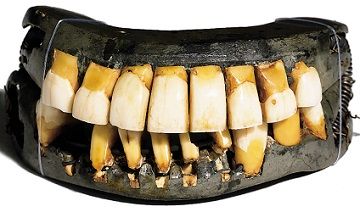The Truth About George Washington's Teeth
What the first president's teeth were actually made of, the pain they caused him, and how they may have altered the course of American history.

As the presidential campaign goes into its final weeks, the candidates double-up on waving, kissing babies, and smiling in selfies with voters. The images show off presidential-style teeth. They shine pearly white, line up straight and perform so well that the candidates just keep chomping on hot dogs, pierogis, bagels and other ethnic fare in swing state neighborhoods, hardly ever giving a thought to their choppers.
But not George Washington. Even though our first president’s campaign was easy—the participating delegates unanimously elected him—Washington had constant problems with his teeth starting in his twenties. Historians assert that Washington must have been in much pain because of his teeth. By his 1789 inauguration, Washington had only one real tooth in his head. The rest were false teeth.

George Washington’s Dentures
The only complete surviving set of George Washington’s dentures are on view at Mount Vernon, George Washington’s beloved plantation on the Potomac River, not far from Washington, DC. Created by New York dentist Dr. John Greenwood, a dental pioneer, Washington’s false teeth were a technological marvel of the 18th century. And they still fit poorly.
Lead was used to create the top and the bottom bases that fit against Washington’s upper and lower jaw. No wooden teeth were ever used. The upper row of the dentures displayed at Mount Vernon consist of horses and donkeys' teeth and the lower row sports a mix of cow’s teeth, elephant and walrus ivory, and actual human teeth. A wire runs through a hole drilled in each tooth to hold it to the base. Metal springs on each side allowed Washington to open his mouth. But to keep his mouth closed, Washington had to apply pressure to the springs, thus creating a slight grimace as he clenched his teeth to keep his mouth shut.
In addition, Washington’s dentures hurt. He complained in a 1797 letter to Dr. John Greenwood that his dentures were “already too wide, and too projecting for the parts they rest upon; which causes both upper and lower lip to bulge out, as if swelled.” Some historians believe that the ill-fitting dentures made Washington self-conscious, causing him to be reluctant to speak.
True Facts and Conjectures about Washington’s Dentures and the British Defeat
The partial dentures Washington wore during the Revolutionary War were created out of ivory by Dr. John Baker who wired the apparatus to Washington’s remaining teeth.
Because Washington’s dentures stained easily, Greenwood advised Washington to clean them with wax and “some chalk and a Pine or Ceder stick…and soake…in Broath.” In his diaries, Washington routinely complained about lost teeth, inflamed gums, aching teeth and ill-fitting dentures. Washington’s accounts regularly show payments to dentists and purchases of toothbrushes, teeth scrappers, denture files, toothache medication and cleaning solutions.
Some historians believe that Washington’s problematic teeth helped the revolutionaries defeat the British at Yorktown. Prior to the battle, the British intercepted a mail packet containing Washington’s letter to his dentist stating that Washington had “little prospect of being in Philadelphia soon” so Washington requested tooth scrapers to be sent to him outside of New York.
When Sir Henry Clinton, commander of the British forces in North America read the letter, he assumed that Washington would not be marching south through Philadelphia to threaten Cornwallis in Yorktown, VA. Clinton did not move quickly to protect Cornwallis. However, unbeknown to Clinton, Washington and Rochambeau had made plans to move south. They successfully trapped and defeated Cornwallis at Yorktown, October 19, 1781. And that’s how teeth played a biting part in the British defeat.
ACTIVA BioACTIVE Bulk Flow Marks Pulpdent’s First Major Product Release in 4 Years
December 12th 2024Next-generation bulk-fill dental restorative raises the standard of care for bulk-fill procedures by providing natural remineralization support, while also overcoming current bulk-fill limitations.